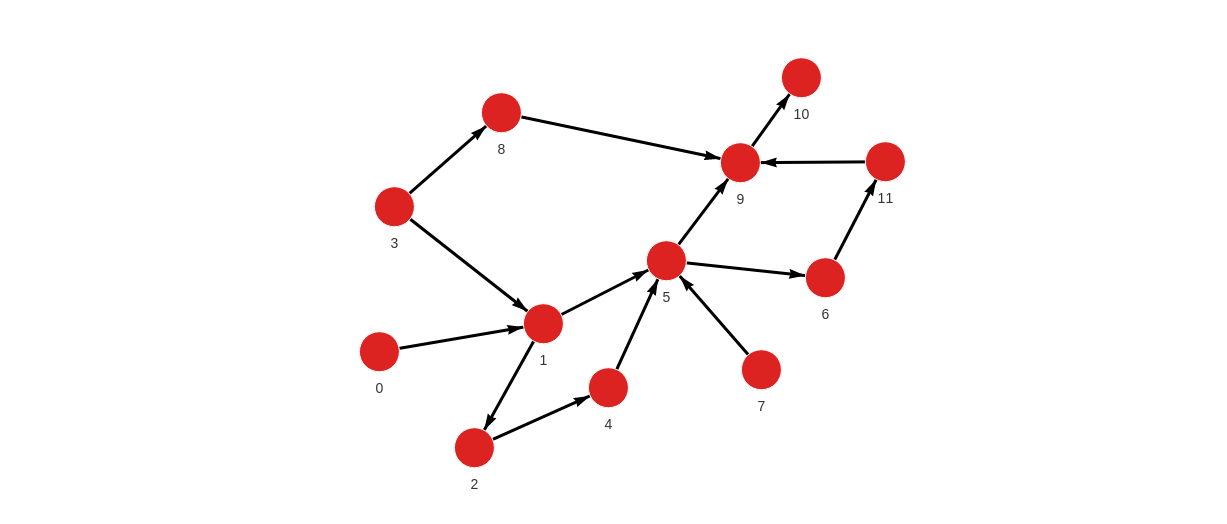betweenness_centrality
Centrality analysis provides information about the node’s importance for an information flow or connectivity of the network. Betweenness centrality is one of the most used centrality metrics. Betweenness centrality measures the extent to which a node lies on paths between other nodes in the graph. Thus, nodes with high betweenness may have considerable influence within a network under their control over information passing between others. The calculation of betweenness centrality is not standardized, and there are many ways to solve it. It is defined as the number of shortest paths in the graph that passes through the node divided by the total number of shortest paths. The implemented algorithm is described in the paper "A Faster Algorithm for Betweenness Centrality" 1.
1 A Faster Algorithm for Betweenness Centrality, Ulrik Brandes
| Trait | Value |
|---|---|
| Module type | algorithm |
| Implementation | C++ |
| Graph direction | directed/undirected |
| Edge weights | unweighted |
| Parallelism | parallel |
Procedures
If you want to execute this algorithm on graph projections, subgraphs or portions of the graph, be sure to check out the guide on How to run a MAGE module on subgraphs.
get(directed, normalized, threads)
Input:
directed: boolean (default=True)➡ IfFalsethe direction of the edges is ignored.normalized: boolean (default=True)➡ IfTruethe betweenness values are normalized by2/((n-1)(n-2))for graphs, and1/((n-1)(n-2))for directed graphs wherenis the number of nodes.threads: integer (default=number of concurrent threads supported by the implementation)➡ The number of threads used to calculate betweenness centrality.
Output:
betweenness_centrality: float➡ Value of betweenness for a given node.node: Vertex➡ Graph vertex for betweenness calculation.
Usage:
CALL betweenness_centrality.get()
YIELD node, betweenness_centrality;
Example
- Step 1: Input graph
- Step 2: Cypher load commands
- Step 3: Running command
- Step 4: Results

MERGE (a:Node {id: 0}) MERGE (b:Node {id: 1}) CREATE (a)-[:RELATION]->(b);
MERGE (a:Node {id: 1}) MERGE (b:Node {id: 2}) CREATE (a)-[:RELATION]->(b);
MERGE (a:Node {id: 3}) MERGE (b:Node {id: 1}) CREATE (a)-[:RELATION]->(b);
MERGE (a:Node {id: 4}) MERGE (b:Node {id: 5}) CREATE (a)-[:RELATION]->(b);
MERGE (a:Node {id: 5}) MERGE (b:Node {id: 6}) CREATE (a)-[:RELATION]->(b);
MERGE (a:Node {id: 7}) MERGE (b:Node {id: 5}) CREATE (a)-[:RELATION]->(b);
MERGE (a:Node {id: 8}) MERGE (b:Node {id: 9}) CREATE (a)-[:RELATION]->(b);
MERGE (a:Node {id: 9}) MERGE (b:Node {id: 10}) CREATE (a)-[:RELATION]->(b);
MERGE (a:Node {id: 11}) MERGE (b:Node {id: 9}) CREATE (a)-[:RELATION]->(b);
MERGE (a:Node {id: 1}) MERGE (b:Node {id: 5}) CREATE (a)-[:RELATION]->(b);
MERGE (a:Node {id: 5}) MERGE (b:Node {id: 9}) CREATE (a)-[:RELATION]->(b);
MERGE (a:Node {id: 2}) MERGE (b:Node {id: 4}) CREATE (a)-[:RELATION]->(b);
MERGE (a:Node {id: 6}) MERGE (b:Node {id: 11}) CREATE (a)-[:RELATION]->(b);
MERGE (a:Node {id: 3}) MERGE (b:Node {id: 8}) CREATE (a)-[:RELATION]->(b);
CALL betweenness_centrality.get(TRUE,TRUE)
YIELD node, betweenness_centrality
RETURN node, betweenness_centrality;
+-------------------------+-------------------------+
| node | betweenness_centrality |
+-------------------------+-------------------------+
| (:Node {id: 0}) | 0 |
| (:Node {id: 1}) | 0.109091 |
| (:Node {id: 2}) | 0.0272727 |
| (:Node {id: 3}) | 0 |
| (:Node {id: 4}) | 0.0454545 |
| (:Node {id: 5}) | 0.2 |
| (:Node {id: 6}) | 0.0636364 |
| (:Node {id: 7}) | 0 |
| (:Node {id: 8}) | 0.0181818 |
| (:Node {id: 9}) | 0.0909091 |
| (:Node {id: 10}) | 0 |
| (:Node {id: 11}) | 0.0181818 |
+-------------------------+-------------------------+
